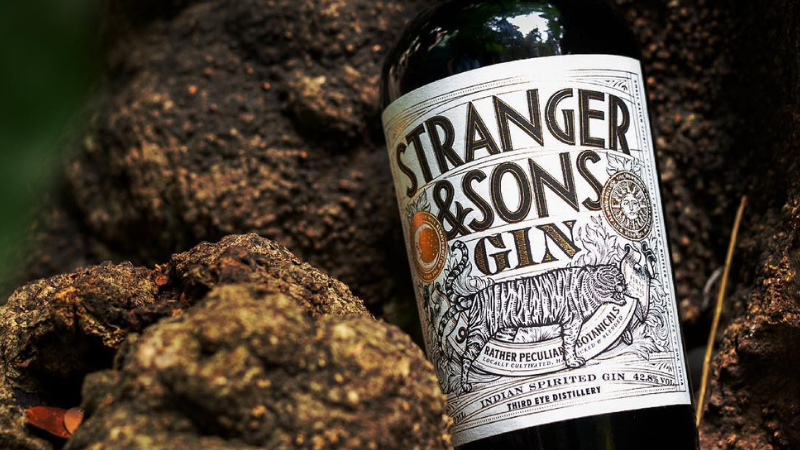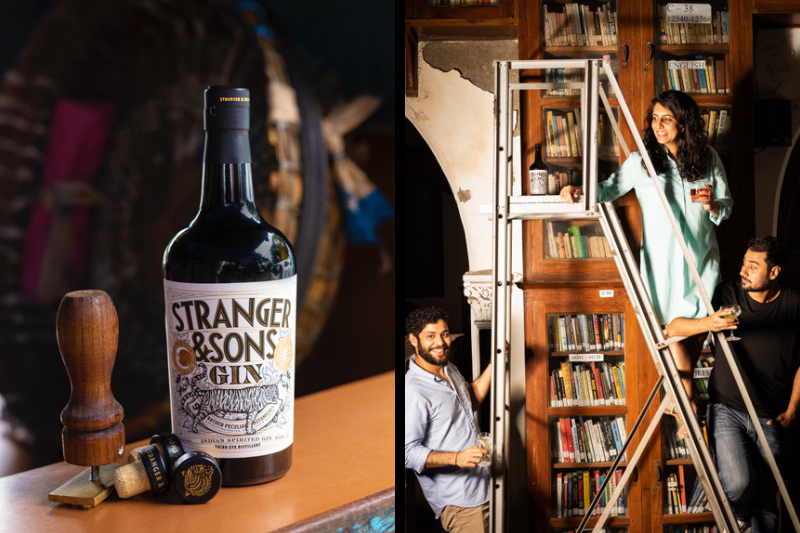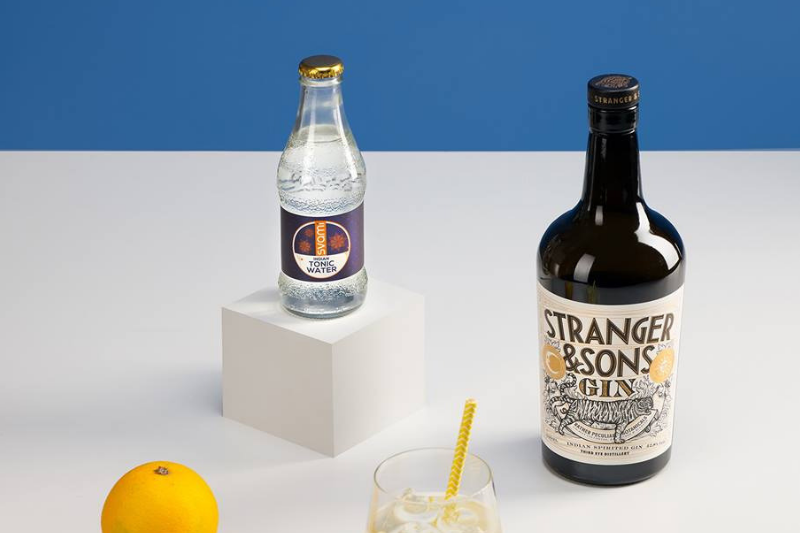
It’s almost Christmas. The spirits are up and the glassware is sparkling. Team DSSC is always on the lookout for small batch, artisanal gins which entice with the aromas of their hand-picked botanicals. Our quest for the best led us to Stranger & Sons, the latest homegrown gin on the block which bears an India-proud label. The gin is distilled in Ponda (Goa), and is prepared with nine botanicals that complement the flavour of juniper.
DSSC sat across the bar with Rahul Mehra, to talk about his brand, the experience of distilling a small batch gin, and everything in between. The bottle has ingredients spelt out in Hindi, and carries a teasing punchline — ‘Rather Peculiar Botanicals’. “We really wanted to celebrate and ensure that the label design proudly showcases its origin and provenance, the nomenclature we use to describe the gin plays a large role in this process,” tells Rahul.
Can you take us through the story of the inception of Stranger & Sons?
My wife Sakshi, cousin Vidur, and I love travelling and share a common interest of visiting local bars in any city we find ourselves in. During our travels, we noticed many bars were experimenting with gin-based cocktails globally, especially since the rise of speakeasies. While you may not find simple gintos at a premium bar in London, classic gin-based cocktails such as the Gimlet and the Last Word are surely making a comeback.
Our first experiment with a batch of gin distilled at home led to the genesis of Third Eye Distillery. Gin manufacturers across the world look at India to not only source botanicals, but also to explore its provenance, to fit their brand and identity. All gins which bear any resemblance to India in their name are made nowhere close to here. That’s when the realization struck that it was time to build a truly Indian gin that was robust and would stand out there in the global market.
What is the story behind the christening of Stranger & Sons?
Traditionally, all businesses in India passed down the generations, borrow their nomenclature from their ancestors’ wisdom. We’ve all seen remnants of this tradition on shop signs that read so and so ‘& Sons’. These shop signs spell out the legacies of these businesses. When it was time to build our own legacy, we took the blessings of our two-tailed, three-eyed mythical creature, and named our brand Stranger & Sons. This gin is our tribute to everything we know today, that was passed down by a person or a creature who knew it before us; and India.
What went into the building of the recipe and distilling a small batch gin?
After having tasted over 400 gins (we’re not complaining), we realised that the key to making a great gin lies in the sourcing of good botanicals, and we had the most exotic botanicals available for use right in our Indian backyard. In choosing to make gin, we managed to create a spirit that celebrates the agricultural history of India in a way no other spirit can.

Stranger & Sons gin; Right: Sakshi, Vidur, and Rahul
In a country which loves its dark spirits, what do you think led to the resurgence of gin on the tipples table?
Besides the fact that all spirits go through these cyclical consumption patterns, the current generation rarely drinks what their parents drank in their time, almost like a quiet rebellion. I feel the main reason gin started trending is because of its versatility, and unintimidating nature as a spirit. Another reason for its popularity is that despite having a deep and complex history of origin, the spirit provides enough room for experimentation to the distiller to be able to develop new and distinct flavour profiles.
In your opinion, are cocktails the easier route to get people to drink gin, considering its impact on the overall cocktail experience is significant?
A Negroni was a really popular gin-based cocktail, which finds space on most Indian bar menus, today. Looking at global trends, bars are moving back to classic gin cocktails, but these will take some time to reach Indian bars as it is difficult to find liqueurs like Chartreuse or vermouths, that are essential for any bar serving gin-based cocktails.
While it would’ve been easier for you to get a craft gin manufactured in a larger distillery, when you look back at the entire process, how was the ease of business and infrastructure provided by the government?
Admittedly, there are a lot of challenges in setting up your own distillery, especially so, for small batch spirits in India. But it is also exciting as we are constantly trying to do our bit to make our distillery more responsible and sustainable. It also gives us the space to experiment with other spirits and variants of gin which we can create in order to showcase the diversity that India represents, to the rest of the world.

svamidrinks.com
Could you tell us about the botanicals used in Stranger & Sons? Which parts of the country do you source them from?
Botanically speaking, our gin goes beyond the customary juniper with healthy measures of Indian black pepper, nutmeg, mace, coriander, angelica with soft notes of familiar and native citrus peels, coupled with a smooth body. It also has the warmth of liquorice and cassia bark to finish. Apart from our juniper which is imported from Macedonia, all other botanicals are sourced locally. Our Gondhraj lemons come from Kolkata, oranges from Nagpur, sweet lime, and Indian lime come from Goa. The coriander, black pepper, nutmeg, and mace are all sourced from spice farms just across our distillery.
Since the soil around our distillery is very fertile, we have started building our botanical garden, where we grow our own lemon and coriander. We’ve also planted Mahogany trees with the dream of growing our own pepper on them one day.
Will the gin be made available in Delhi? If not, what are the challenges to enter this market?
We’ll launch in Delhi in April 2019. The challenges lie mainly towards our own bandwidth, when it comes to handling the brand correctly in all markets we want to be present in.
Where do you think the Indian alco-bev industry is headed? Is India on the cusp of a revolution in the craft & artisanal beverage space?
People travel and that’s always a big influence when you watch trends move from country to country. The gin & tonic trend (at least the way we know it today) started in Spain which was always known for its wines and sangrias, but suddenly Spain become synonymous with gin & tonic. This spread to Europe, and eventually made inroads into urban India by way of a small demand for imported gins. Trends don’t just disappear, they will leave a mark. Gin, around the world is going through this renaissance phase where there aren’t just new consumers every minute, but new gins too.
What’s next on anvil from the house of Third Eye Distillery?
We’re as curious as it gets about exploring and experimenting with new and strange ideas. At the moment, we’re looking at using indigenous woods for ageing our gin and rum. We are also trying to source local sustainably grown berries, and honey. But we’re more than eager to prove to the world that India can make more than just its fair share of whiskey.
Rahul sums up the launch of Stranger & Sons by sharing, “Gin is just the first chapter in the book of our spirits. We’re constantly experimenting and looking to expand our portfolio to bring forth the diversity that India represents, out into the rest of the world.” Here’s raising a toast to that!
Disclaimer: The opinions expressed in this feature are those of the interviewee and do not necessarily reflect those of DSSC & its affiliates.

